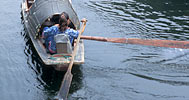China Travel Photography |
||
|
|
China Travel Photography |
||
|
|

故宫Gugong (the Forbidden City), the imperial palace of the 明Ming (1368-1644) and 青Qing (1644-1911) emperors for the last 500 odd years, is today popularly known by one of its old name 紫禁城, literally -- Purple Forbidden City, but translations usually leave out the word "Purple" (the imperial color) for more dramatic effect. It is no longer forbidden, however, and tourists now stroll through the public museum in waves. While I was there, the entire complex, as well as other well-known structures such 天坛Tiantan (The Temple of Heaven), were under major renovation. Everything will be repainted. So that when you get there for the August 8, 2008 Beijing Olympics, they will look as fresh as its inauguration day.
Gugong Palace has its beginings during the Ming dynasty. The fourth son of the dynastic founder, 朱棣Zhudi usurped the throne and, to the great dismay of the 南京Nanjing citizens, decided to move the capital to Beijing. On the center of that Beijing city, and to the east of the razed Mongol palace was the ground for the new palace - a secretive Forbidden City within the mighty walls of Beijing City. The architect was 蒯祥Yixiang, a former carpenter. His layout for the Forbidden City was a rectangular labyrinth, with the walls lined along the 4 polar directions and a moat surrounding the palace. Gugong Palace was a characteristically chinese modular design - one large set repeated hierarchically. From heaven, it looks like a computer chip.
--- June 04, 2010 --- A video shot of a typical street scene in 绍兴Shaoxing in 浙江Zhejiang province.
--- May 28, 2010 --- A video clip of night scenes in the beautiful city of 苏州Suzhou.
Construction of Gugong Palace began during the fourth year of his 永乐Yongle reign (1406), and completed about 14 years later.
But during its long wooden life, several fire (often caused by lightning) had done serious damage to it, so that some buildings were rebuilt during the 24 reigns.
Many more buildings were also added to the Forbidden City as each new emperor wanted something for themselves or their favorites. Thus, by the end of Qing (1911), Gugong had over 9000 rooms in
720,000 square meters of ground area. Small wonder it is the largest palace complex in the world today — literally a city.
![]()
故宫Gugong (The Palace Museum) is at the heart of the city. On the map its rectangular layout, along with the 天安门广场Tiananmen Square, took up much of the space. You will see that many buses can get near there. You can enter the palace through its north and south entrance. The most popular is the south entrance, which is through the 天安门Tiananmen Gate, then through the 午门Wumen Gate ( Meridian Gate ) -- the main gate to the palace. If you don't like the crowd or to wait on line, the north entrance - 神武门Shenwumen (Divine Martial Gate) -- is a better option. Plus the north has the 景山Jingshan hills and the closer moat to look at while you wait.
60 Yuan (Summer 2006). 50 Yuan (Autumn 2009).
Corrections? Comments? Feedbacks? Please let me know
This site contains Chinese characters. For proper view of this site, please install Chinese (simplified) or East Asian languages in your system.
Without proper rendering support, you may see question marks, boxes, or other symbols instead of Chinese characters.
版权所有 All Images, Text, Videos, Maps, Designs and Website -- Copyright © 2005-2010 King Wong All Rights Reserved. Legal Info